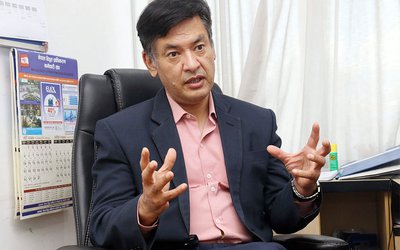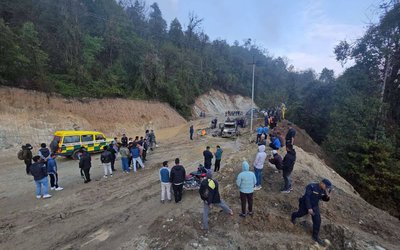One should now not hesitate to declare that fiscal year 2079\80 (2022\23) was a very bad year as data made available by the concerned agencies adequately reveal the very poor performance of the economy during the twelve months. Economic growth dropped to less than 2 percent, foreign trade shrank and revenue collection dropped so much that it could not meet even the recurrent expenditure of Nepal government, let alone generating surplus for development activities. Compared to a year earlier level, revenue collection in the last fiscal year( FY) dropped by about Rs. 110 billion, exerting tremendous pressure on Government’s fiscal position, which remained at a deficit of about Rs.487 billion. This unpleasant situation, revenue not being able to meet recurrent expenditure and budget deficit swelling so much, recurred one more time after years, knowledgeable people observe. Government had no problem spending money kept under recurrent head of the budget but capital expenditure remained low as usual, exceeding the expenses under financing expenditure head (debt servicing) just by Rs. 11 billion. Capital expenditure and debt servicing remained, respectively, at Rs.233 billion and Rs.222 billion.It is a matter of common knowledge that when development expenditure of the government slacks, revenue collection also suffers. It may also be noted that in addition to this low public sector expenditure, contraction in international trade of Nepal (by about 16 percent compared to a year earlier level) negatively impacted revenue collection during the period. Depleting foreign exchange reserve at that time forced the government to impose restrictions on import of certain items, which contributed to contraction in import, and export declined as usual. Not only on the internal resource mobilization front, government suffered setback on external resource mobilization (both grant and loan), too. Available data reveal that in the last five years, on average, only about 51 percent of the targeted foreign loan has been received, the achievement being only 42 percent last FY. More than seven hundred thousand people left the country for employment outside of Nepal, which is an indication of deplorable condition within the country. Average inflation approximated 8 percent during the period. It may also not be inappropriate to mention that Nepal imported apple worth Rs.7 billion and banana import approximated Rs.1.62 billion last FY. Let us hope these disappointing facts and figures will not much offend thick-skinned Deuba and Prachanda who took turn in managing state affairs during the period and their very loyal and sincere followers, about three, who obediently carried out their duty at the finance ministry as directed by their respective bosses. Very frustrating, however, for us is the reality, as shown by available facts, that even the current FY (2023/24) is not likely to be any better.
It is not easy to agree with Asian Development Bank’s expectation that Nepal’s economy will make improvement in the current FY because early indications do not encourage anyone to be much optimistic. Last FY being a very disappointing period, weak base year effect is likely to be there, but the growth is not likely to be anywhere near the wished 6 percent. Last year, a pathetic growth of 1.9 percent threw lots of cold water on estimates of some over optimistic multilateral agencies. Capital expenditure stands at just 2.81 percent of the allocated Rs.302 billion even after expiry of the first two months of the current FY. During this period, government was expected to spend more than Rs. 10 billion, while the actual capital expenditure has been Rs.8.49 billion. Slacking capital expenditure seems to be exerting negative impact on revenue collection, which approximated Rs.141 billion, Rs.2 billion less than what was collected during the corresponding period of last FY. Revenue and other income have also fallen short by about Rs. 9 billion. Unsatisfactory revenue collection has forced Nepal government to borrow Rs.72.31 billion internally till first of October mainly for recurrent expenditure. Likewise, in the two months, import declined by 5.06 percent, export by 7.79 percent and total trade contracted by 5.32 percent, compared to the two months of the last FY. This contraction in trade could have further serious revenue implications, which was seen last FY and is likely to continue this year, too. Compared to the 2 months of last FY, export declined by 7.79 percent, which explains just 9.24 percent of the total trade. It may also be difficult to contain budget deficit at 2.4 percent of GDP, which is lower than 6.1 percent deficit of last FY. In the event of government failing to achieve the ambitious target of revenue collection (Rs.1422.54 billion), which is most likely to remain unachieved as is indicated by early signs of contraction in foreign trade, budget deficit is likely to shoot up. Reports from major revenue collection points in the country are not at all encouraging, which is blamed on contraction in international trade and continued slackness in economic activities. Some improvements in the external sector could be cited to draw satisfaction from but the current FY is not likely to be much different from the preceding year. Indeed, ADB’s prediction of 4.1 percent growth in the current year, if materialized, would be something to celebrate and rejoice over. The World Bank has also stated that the growth would be somewhere near 4 percent. Beside remittance, which is helping the economy breath so far, no encouraging signs are visible in any other area to draw solace from. It would be interesting to touch upon the state of some sectors of the economy.
Despite reduction in contribution of farm sector to annual gdp (from 29.39 percent in 2071\72 to 24.1 percent in 2079\80), agriculture still remains a major sector of the economy in terms of engaging a significant portion of Nepal’s population. It may be noted that about 57 percent of people above 10 years of age are engaged in agriculture and the sector engages about 62 percent of total households in Nepal but the pathetic fact to be noted is that about 55 percent of them grow less food than what is required throughout the year. Long ago, government announced that Nepal would soon be self-reliant on products like paddy. Unfortunately, however, import of agricultural products like paddy\rice is on the rise. Poor performance of agriculture is often blamed on lack of fertilizer and other inputs, inadequate irrigation facility and shortage of labour. Disappointing is also the contribution of industrial sector, accounting for about 13 percent of gdp, and service sector has also not impressively contributed towards generation of employment within the country.
Common people are not only hit hard by soaring market prices of edibles but also by intolerable hike in prices of fuel and cooking gas by government-owned agencies such as Nepal Oil Corporation(NOC). It is understood that administered prices here are synchronized with Indian\international prices and the concerned here have no choice but to walk the path drawn by others but the point to be considered is the insensitivity of our government towards major problems of inflation-hit consumers at a time when our major annual festivals are knocking on the door. Tax waiver could be taken resort to and money from stabilization fund could be used for a specific period of time to provide some relief to consumers. Nepal government collects about Rs.335.79 from each cylinder of cooking gas and Rs.63.86 from each liter of petrol. Government intervention directing NOC to retract its most ill-timed decision to hike fuel prices has given a signal that the dispensation does at times pay attention to suffering of the people. People definitely need a responsive and responsible government to address their problems because they know days ahead are going to be all the more difficult. Rising fuel prices on the global market, Russia’s decision to walk out of Black Sea grain deal, obstructing shipment of Ukrainian grains, and government of India’s decision to discourage export of items like grains and sugar have already complicated the situation for a country like Nepal, which imports everything, from food to fuel. Sugar is hardly seen in the market and a few lucky ones get it paying exorbitant price. Prime Minister Prachanda, looking sandwiched between Chinese BRI and American MCC, will have to pay more attention to the long-ignored commoners, especially in view of their imminent annual festivals. It has now become a common knowledge that economic miseries and rampant corruption have fueled mass resentment and Nepalis are desperately wanting a major political change, which could ensure good governance of this country. Tired and sick of incessant scandals, involving influential leaders and their family members, increasing number of people have begun to believe that injustice was meted out to King Gaynendra and the institution of monarchy should now be constitutionally given a respectable place. It should also not be forgotten that, in addition to economic hardship and corruption, decent behavior and sobriety of the royal couple, has greatly enhanced popularity of the King amongst people who throng in thousands to see the monarch in person. Indeed, people need a guardian of the nation in these terrible times.
People want the prominent operators of this country (Deuba, Prachanda and Oli) to understand that our country is just on the edge of a serious crisis (economic and political) prolonged inattention to which could give rise to violent unrest in the country. Make no mistake, the twin issue of monarchy and religion cannot now be suppressed for long. Preference of the people is for a peaceful resolution of the problem, which is not difficult, provided the rulers of this country realize the reality and open the door for change. These leaders, some of whom may now be finding it difficult to be on their feet, have had enough and they should refrain from making conspiratorial political moves to suppress the voice of people wanting peaceful change in the country.
Dr. Rawal is a former governor of NRB

Dr. Tilak Rawal
Dr. Rawal is former governor of NRB.
- Six Months Of Deuba And Oli
- Jan 25, 2025
- Prachanda Outsmarted
- Jul 19, 2024
- Prachanda Outsmarts Again
- Apr 14, 2024
- Prachanda Completes One Year
- Jan 26, 2024
- Budgets Of Nepal
- Jun 09, 2023














